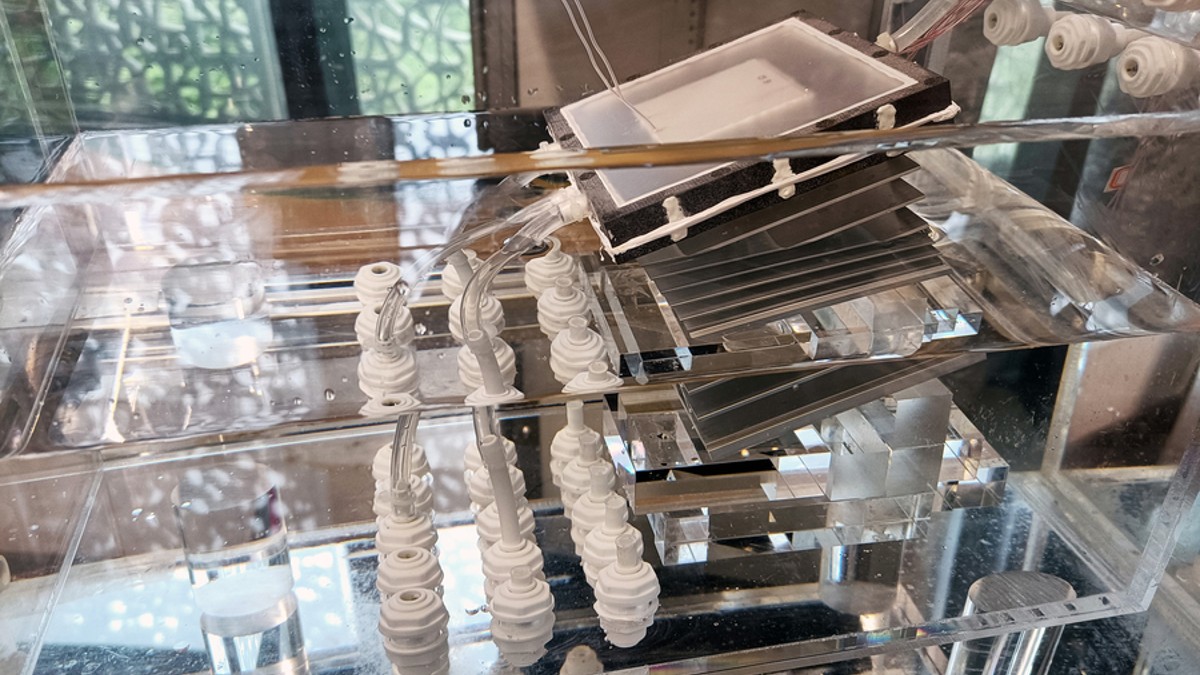
MIT scientists have designed a solar-powered desalination system that turns saltwater into drinkable water at a higher volume – and lower cost.
Researchers from MIT and Shanghai Jiao Tong University have published a paper, “Extreme salt-resisting multistage solar distillation with thermohaline convection,” in the journal Joule about a study that has the potential to make a big leap forward in reducing the cost of water production because it doesn’t require electricity to run.
The device they built creates circular currents of water known as eddies that look like small whirlpools that function similarly to the ocean’s much larger thermohaline circulation. This circulation, combined with the sun’s heat, drives water to evaporate, leaving salt behind.
Lenan Zhang, a research scientist in MIT’s Device Research Laboratory, explains:
When seawater is exposed to air, sunlight drives water to evaporate. Once water leaves the surface, salt remains. And the higher the salt concentration, the denser the liquid, and this heavier water wants to flow downward.
By mimicking this kilometer-wide phenomena in a small box, we can take advantage of this feature to reject salt.
How it works
Scientists used a small, thin box topped with a dark material that efficiently absorbs the sun’s heat. Inside, the box is separated into a top and bottom section. Water can flow through the top half, where the ceiling is lined with an evaporator layer that uses the sun’s heat to warm up and evaporate any water in direct contact. The water vapor is then funneled to the bottom half of the box, where a condensing layer air-cools the vapor into pure drinkable water.
The researchers set the entire box at a tilt within a larger empty vessel, then attached a tube from the top half of the box down through the bottom of the vessel, and floated the vessel in salt water. The water naturally pushes up through the tube and into the box, where the tilt of the box, combined with thermal energy from the sun, induces the water to swirl as it flows through. The small eddies help to bring water in contact with the upper evaporating layer while keeping salt circulating rather than settling and clogging.
Other passive solar desalination concepts are currently being tested by other teams, but the MIT researchers say their new system has higher water-production and salt-rejection rates.
They assert that if the system is scaled up to the size of a small suitcase, it could produce about 4 to 6 liters (1 to 1.5 gallons) of drinking water per hour and last several years before requiring replacement parts. At that scale and performance, the system could produce drinking water at a rate and price that’s cheaper than tap water.
A scaled-up device could passively produce enough drinking water to meet the daily requirements of a small family. It could also supply off-grid coastal communities near seawater.
What do you think of this solar-powered desalination system? Do you think this would, in theory, provide relief for folks in Louisiana whose drinking water is threatened by saltwater from the Gulf of Mexico that’s infiltrating the Mississippi River due to drought? Let us know in the comments below.
Read more: US solar is booming – here’s the newly released data
Photo: MIT
If you’re considering going solar, it’s always a good idea to get quotes from a few installers. To make sure you find a trusted, reliable solar installer near you that offers competitive pricing, check out EnergySage, a free service that makes it easy for you to go solar. It has hundreds of pre-vetted solar installers competing for your business, ensuring you get high-quality solutions and save 20-30% compared to going it alone. Plus, it’s free to use, and you won’t get sales calls until you select an installer and share your phone number with them.
Your personalized solar quotes are easy to compare online, and you’ll get access to unbiased Energy Advisors to help you every step of the way. Get started here. –ad*
FTC: We use income earning auto affiliate links. More.



Comments